 |
Picks is a monthly sampling of Japan's art scene, offering commentary by a variety of reviewers about exhibitions at museums and galleries in recent weeks, with an emphasis on contemporary art by young artists. |
 |
 |
 |
1 December 2017 |
 |
| 1 | 2 | |
 |
|
 |
 |
|
|
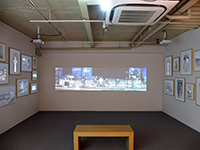 |
|
| Yukihiro Yamagami: air scape / location hunting 2017 |
| 10 October - 5 November 2017 |
Gallery PARC
(Kyoto) |
 |
| Yamagami is known for his novel "canvas projection" technique, in which he takes a still photo of a selected location, painstakingly reproduces the scene in pencil, then shoots a fixed-point video of the same scene, and finally projects the video image onto the pencil drawing. This superposition of drawing and video expresses space and time in a manner unlike either of the two media alone. This show served as a retrospective of the artist's major works to date. |
|
|
 |
 |
|
| Chikako Shibata |
| 16 - 28 October 2017 |
Gallery Haku Kuro
(Osaka) |
 |
| Gallery Haku is unique in having a "black cube" space on its premises, aptly named Kuro, i.e. Black. Kuro is used mostly to display sculptures and other solid works, but Shibata proved that paintings can also thrive here. Her abstractions, dominated by deep blues and blacks, were longer than the walls and hence were arranged diagonally across the room. Too big to grasp at one glance, they compelled viewers to walk around taking them in from different vantage points, an effort rewarded by a profound and visually pleasurable experience. |
|
|

|
 |
 |
|
 |
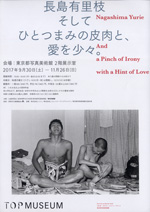 |
 |
| Nagashima Yurie: And a Pinch of Irony with a Hint of Love |
| 30 September - 26 November 2017 |
Tokyo Photographic Art Museum
(Tokyo) |
 |
| In this solo exhibition, Nakashima reviews the 25-year career she launched in 1993 with controversy-stirring nude portraits of herself and other members of her family. It's a comprehensive look at what has changed and what has not in her approach to photography. There is a vitality to her early work, but it is her more recent output, produced while negotiating marriage, childbirth and divorce, that testifies to her maturation as a photographer. |
|
|
|
|
|
|
|

|
 |
 |
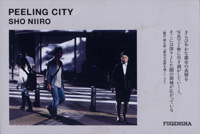 |
 |
| Sho Niiro: Peeling City |
| 26 September - 7 October 2017 |
Communication Gallery Fugen-sha
(Tokyo) |
 |
| Niiro has been shooting Tokyo and its environs since before the Great East Japan Earthquake of 2011. This show commemorated the publication of his latest photo collection by the same title. Niiro's equal treatment of diverse subjects at varying emotional distances is reminiscent of the work of veteran photographer Yutaka Takanashi. The helmet that appears as one subject seems to represent a means of bodily protection from the dangers lurking in present-day Tokyo. |
|
|
 |
 |
| Yu Kanbayashi: 6th Emon Award Exhibition |
| 3 - 14 October 2017 |
Emon Photo Gallery
(Tokyo) |
 |
| Kanbayashi's style belongs to the lineage of conceptual photography -- but rather than adhering to some rigorous methodology, his works take a light, airy approach to the observation of everyday events. The images in this show highlighted the sure hand and meticulous technique with which he captures the serene beauty of tracks and traces left behind by motions of various sorts. Expect great things from him if he continues to pursue this direction. |
|

|
 |
 |
 |
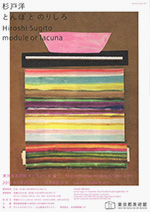
|
|
| Hiroshi Sugito: module or lacuna |
| 25 July - 9 October 2017 |
Tokyo Metropolitan Art Museum
(Tokyo) |
 |
| Sugito has won admirers both in his home country and abroad, but this is his first solo outing in a Tokyo museum. The ingenious layout seems geared toward showcasing not so much his paintings' content as their presence as objects, their arrangement, and the entire space they inhabit. It's a very large space, but Sugito has filled them with very small works. The effect is not ironic, but convincing and impeccably tasteful. |
|
|
 |
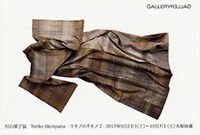 |
 |
| Yoriko Murayama: Clothes of Mammals 2 |
| 23 September - 7 October 2017 |
Gallery Gallery
(Kyoto) |
 |
| In this solo exhibition, textile artist Murayama displayed four kimonos woven in the image of animal furs and dyed with acorn, sophora, cherry, bayberry and other wild plants. This second in her "Clothes of Mammals" (Kemono no Kimono) series contemplates the origins of clothing, its magical properties of mimicry and disguise, and the way it fosters both distance and continuity between the skin, the outer world, people and nature. These are marvelous works of delicate savagery. |
|
|
|
|
|
|
|
|
|
 |
|